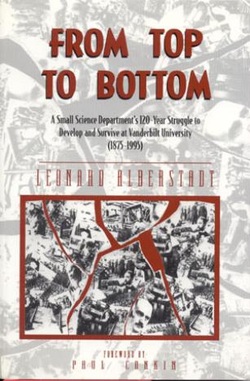About the Author:

Len Alberstadt is professor emeritus at Vanderbilt University. He presently resides in Kingston Springs, TN and can be reached at lalberstadt9000@bellsouth.net.
BUY LEN'S BOOKS NOW
The Gregory's Gabriella

Three friends, Herwald, Fritz, and Gabriella, all German university students in 1929. Their
visions for the future are still unclear but suddenly find everything altered dramatically by Adolf Hitler's rise to power and the subsequent domination of Germany by the Nazi Party. Each one of them undergoes personal struggles as World War II takes hold of their country and, eventually, the entire world.
Herwald, a Jew, escapes Germany and gets to England where he continues his studies of the atom at several British universities. Fritz, the only surviving son of a military family, joins the German army and eventually becomes a high-ranking German officer who, to his unhappiness, finds himself assigned to lead a unit that is responsible for keeping track of Jews and other so-called "undesirables" throughout Northwestern Germany. Gabriella, a Jewess, the girl loved by Fritz since their days at the university, finds herself moving along a different path, away from a life of marriage and family. She foregoes her Jewish upbringing and converts to Catholicism and, a short time later, becomes a Carmelite nun.
What happens to each of these three people over the course of the war and how their lives remain connected, even as they are separated by considerable geographic distance, is the heart of the story.
visions for the future are still unclear but suddenly find everything altered dramatically by Adolf Hitler's rise to power and the subsequent domination of Germany by the Nazi Party. Each one of them undergoes personal struggles as World War II takes hold of their country and, eventually, the entire world.
Herwald, a Jew, escapes Germany and gets to England where he continues his studies of the atom at several British universities. Fritz, the only surviving son of a military family, joins the German army and eventually becomes a high-ranking German officer who, to his unhappiness, finds himself assigned to lead a unit that is responsible for keeping track of Jews and other so-called "undesirables" throughout Northwestern Germany. Gabriella, a Jewess, the girl loved by Fritz since their days at the university, finds herself moving along a different path, away from a life of marriage and family. She foregoes her Jewish upbringing and converts to Catholicism and, a short time later, becomes a Carmelite nun.
What happens to each of these three people over the course of the war and how their lives remain connected, even as they are separated by considerable geographic distance, is the heart of the story.
Poncomma

About Poncomma
6x9 inches, Perfect bound, 424 Pages, $21.95
ISBN: 978-0-9816172-8-2
Delsin Cole, the only son of an Oklahoma rancher, is a talented high school football player raised in small town Poncomma. He is recruited by almost every university in the country with a major football program. When he decides to forego all the schools with their “bigger than life” athletic notoriety to cast his lot with Vanderbilt University almost everyone in Poncomma is shocked and disappointed.
Feeling this outside pressure and expectations of athletic greatness he is also troubled because his leaving for college comes at a bad time. His family is in a battle with State officials who want to force the sale of part of the Cole ranch for the construction of a
large lake and regional recreational park. This prospect is wearing on Delsin’s father and Delsin feels helpless to help him, and somewhat reluctant to leave home.
Once at Vanderbilt Delsin’s new environment takes some getting used to; there are new attitudes, students, professors, and new circumstances which he must face. He meets Patty. Elegant and poised, she brings to him new feelings that he cannot shake off. He struggles with them while trying to move into a full life as a student and football player where he must cope with the demands each requires.
Delsin also meets Benny Bromono, a young man ten years his senior who seems worldly and sophisticated, yet possessing a mysterious bit of wiliness. Delsin is almost transfixed by Benny’s manner and capabilities. It is Benny who affects the fortunes of the Cole family and it is Benny and all his wiliness who is instrumental in Delsin’s very survival. It is largely because of Delsin’s
ability as a football player that he winds up at Vanderbilt. What happens to him leads ultimately to bringing Vanderbilt University and the people of Poncomma, Oklahoma to a unique relationship.
6x9 inches, Perfect bound, 424 Pages, $21.95
ISBN: 978-0-9816172-8-2
Delsin Cole, the only son of an Oklahoma rancher, is a talented high school football player raised in small town Poncomma. He is recruited by almost every university in the country with a major football program. When he decides to forego all the schools with their “bigger than life” athletic notoriety to cast his lot with Vanderbilt University almost everyone in Poncomma is shocked and disappointed.
Feeling this outside pressure and expectations of athletic greatness he is also troubled because his leaving for college comes at a bad time. His family is in a battle with State officials who want to force the sale of part of the Cole ranch for the construction of a
large lake and regional recreational park. This prospect is wearing on Delsin’s father and Delsin feels helpless to help him, and somewhat reluctant to leave home.
Once at Vanderbilt Delsin’s new environment takes some getting used to; there are new attitudes, students, professors, and new circumstances which he must face. He meets Patty. Elegant and poised, she brings to him new feelings that he cannot shake off. He struggles with them while trying to move into a full life as a student and football player where he must cope with the demands each requires.
Delsin also meets Benny Bromono, a young man ten years his senior who seems worldly and sophisticated, yet possessing a mysterious bit of wiliness. Delsin is almost transfixed by Benny’s manner and capabilities. It is Benny who affects the fortunes of the Cole family and it is Benny and all his wiliness who is instrumental in Delsin’s very survival. It is largely because of Delsin’s
ability as a football player that he winds up at Vanderbilt. What happens to him leads ultimately to bringing Vanderbilt University and the people of Poncomma, Oklahoma to a unique relationship.
How the Rocks Began to Speak

About How the Rocks Began to Speak
by Len Alberstadt
6.14 x 9.21 inches; Perfect Bound; 312 pages, $19.95
ISBN: 1-933912-79-0
THERE CAN BE LITTLE DOUBT that we live in a time when science looms large in our lives. The last two centuries could be thought of as the “age of science,” and the reasons that brought about that age are many and complex. The history of the development of this science has been studied and written about by many people and they have done so for different reasons and with different points of view.
As for this book, the author's purposes are several, but all are related. The first is to give the reader a brief overview of some of the main events that brought about this age of science; the second is to give the reader a sense of how science, and scientists work, and, the third, but somewhat more restricted, yet, nonetheless, related, is to give the reader some insights into the main events in the history of the science of geology and describe some of the important ramifications of the truths that geologists, as scientists, have contributed to the body of scientific knowledge.
It is important to recognize that geology is a science that concerns itself with things that are somewhat more historical than much of
physics, chemistry, and biology. At its heart geology is a historical science, and many, if not all, of its concerns involve the element
of time and sequences of events. For this reason the early development of geology required a slightly different approach from that
required by the other science disciplines. But make no mistake, the fundamental methodology used by geologists is the same as that used by any scientist working in any scientific discipline. That methodology came about largely in the seventeenth and eighteenth centuries and is still the methodology in use today, by all scientists. The ultimate goal here is to provide the reader with a broad framework for understanding the history of that method and its role in geology and in science in general.
by Len Alberstadt
6.14 x 9.21 inches; Perfect Bound; 312 pages, $19.95
ISBN: 1-933912-79-0
THERE CAN BE LITTLE DOUBT that we live in a time when science looms large in our lives. The last two centuries could be thought of as the “age of science,” and the reasons that brought about that age are many and complex. The history of the development of this science has been studied and written about by many people and they have done so for different reasons and with different points of view.
As for this book, the author's purposes are several, but all are related. The first is to give the reader a brief overview of some of the main events that brought about this age of science; the second is to give the reader a sense of how science, and scientists work, and, the third, but somewhat more restricted, yet, nonetheless, related, is to give the reader some insights into the main events in the history of the science of geology and describe some of the important ramifications of the truths that geologists, as scientists, have contributed to the body of scientific knowledge.
It is important to recognize that geology is a science that concerns itself with things that are somewhat more historical than much of
physics, chemistry, and biology. At its heart geology is a historical science, and many, if not all, of its concerns involve the element
of time and sequences of events. For this reason the early development of geology required a slightly different approach from that
required by the other science disciplines. But make no mistake, the fundamental methodology used by geologists is the same as that used by any scientist working in any scientific discipline. That methodology came about largely in the seventeenth and eighteenth centuries and is still the methodology in use today, by all scientists. The ultimate goal here is to provide the reader with a broad framework for understanding the history of that method and its role in geology and in science in general.
From Top to Bottom

From Top To Bottom - A Small Science Department's 120-Year Struggle to Develop and Survive at Vanderbilt University (1875-1995)
by Leonard Alberstadt
Publisher: Eggman Publishing, Inc.; 1995
Edition: Perfect bound; 212 pages; 6 x 9 inches
ISBN: 1-886371-24-5 $14.95
From Top To Bottom is an account of the science of geology at Vanderbilt from the founding days of the institution up to the present. It begins in 1873 when Bishop Holland McTyeire appointed the best faculty available to him. In geology it was a
faculty that made the department one of the best in the institution. This story takes the reader through the decades during which critical curriculum decisions were made and new priorities regarding medical education took stronger hold on the university.
The arrival of big science after WWII drove geology downward even more until in the early 1970's the department came close to being abolished. Since then, especially with the financial help of some alumni, it has been making a comeback, and today there may be a glimmer of hope for meaningful rebirth. It shows those times of administration apathy which slowly, yet methodically, helped relegate geology to second-class status.
This is a case history depicting many of the academic trials of faculty, students, and administrators, both past and present, as
they grappled with changing missions and expectations within a major research university.
by Leonard Alberstadt
Publisher: Eggman Publishing, Inc.; 1995
Edition: Perfect bound; 212 pages; 6 x 9 inches
ISBN: 1-886371-24-5 $14.95
From Top To Bottom is an account of the science of geology at Vanderbilt from the founding days of the institution up to the present. It begins in 1873 when Bishop Holland McTyeire appointed the best faculty available to him. In geology it was a
faculty that made the department one of the best in the institution. This story takes the reader through the decades during which critical curriculum decisions were made and new priorities regarding medical education took stronger hold on the university.
The arrival of big science after WWII drove geology downward even more until in the early 1970's the department came close to being abolished. Since then, especially with the financial help of some alumni, it has been making a comeback, and today there may be a glimmer of hope for meaningful rebirth. It shows those times of administration apathy which slowly, yet methodically, helped relegate geology to second-class status.
This is a case history depicting many of the academic trials of faculty, students, and administrators, both past and present, as
they grappled with changing missions and expectations within a major research university.
Dragons of St. George

“Unless everyone plays by the same rules...universities that make serious efforts to minimize conflicts of interest could be at a disadvantage in recruiting scientists who enjoy lucrative financial relationsihps with the private sector” (Science, 1990). From this apparently benign and scholarly observation, quoted in the volume epigraph, springs the dark seed of the dragons that doom a respected private university.
What is the functtion of a university? Though that question is never explicitly asked in Dragons of St. George, it hovers over the increasingly horrific events that overtake a small university campus and rock the international political balance of the contemporary world.
If your taste in page-turning thrillers runs away from the real world and toward the fantasy land of macho heroes and clear-cut solutions, do not begin this book. You will find it too disturbing.
What is the functtion of a university? Though that question is never explicitly asked in Dragons of St. George, it hovers over the increasingly horrific events that overtake a small university campus and rock the international political balance of the contemporary world.
If your taste in page-turning thrillers runs away from the real world and toward the fantasy land of macho heroes and clear-cut solutions, do not begin this book. You will find it too disturbing.